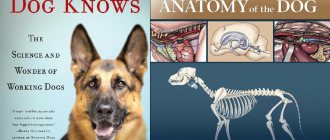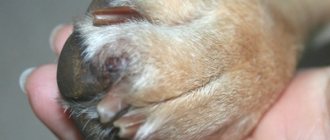What is kennel cough?
Kennel cough in dogs is an infectious disease that primarily affects the upper respiratory tract of the animal. In terms of the development of the disease and clinical signs, it can be compared with human influenza.
If treatment is started on time, the prognosis is extremely favorable. But if you let everything take its course, serious consequences may arise in the form of a secondary bacterial infection and pneumonia.
Often this disease is also called adenovirus, infectious tracheobronchitis, aviary cough or dog flu.
Kennel cough can be caused by several viruses. The symptoms of the disease when infected with any type of virus are similar. Therefore, all these “subspecies” were combined into one general group of “kennel cough”.
The culprits of the infection are the following types of viruses:
- Parainfluenza virus.
- Bordetella bronchiseptica.
- Adenovirus types 1 and 2.
- Reovirus types 1, 2 and 3.
- Canine herpes virus.
Since the causative agents of kennel cough are different, it is important to correctly diagnose, identify the real “culprit” of the cough and prescribe effective treatment.
Causes
The occurrence of aviary influenza in dogs can be provoked by a whole group of viruses: parainfluenza, canine adenovirus (type 2) or distemper. Sometimes combinations of viruses and bacteria can be very complex. There is a small chance that the herpes virus may also be involved in the combinations. But so far this assumption has not been confirmed by clinical studies.
In young dogs and puppies, the main causative agent of infectious cough is considered to be the bacterium Bordetella Bronchisetica. But most often pseudomonads, pathogenic strains of Escherichia coli and Friedlander's bacillus are involved in combination with it. But they cannot provoke a cough on their own - they are secondary agents and join the primary viral infection.
Under concomitant conditions that facilitate the spread of the virus, the course of the disease worsens. Therefore, you need to carefully monitor the absence of sudden temperature changes and drafts in the room, good ventilation and humidity levels.
Routes of infection
Kennel cough in dogs is a viral disease. It can easily be transmitted by airborne droplets from a sick animal to a healthy one. Just a few seconds of direct contact are enough.
This is why cough is called kennel or aviary cough, because it instantly spreads among animals that are close to each other.
You are most likely to catch an infection in places where there are large concentrations of dogs. And these are kennels, animal shelters, clubs, dog shows and veterinary clinics. Yes, if you go to a veterinary clinic with any other problem, your pet runs the risk of additionally contracting kennel cough if a sick animal is near you.
The source of infection can be either direct contact or remnants of saliva from an infected animal.
Absolutely any four-legged animal can become infected. But young puppies, older dogs and animals with weakened immune systems are especially susceptible to infection.
Due to the structural features of the jaw apparatus, dog breeds such as bulldogs and pugs suffer the disease much more severely.
In confined spaces, the infection spreads faster.
Possible complications of infectious laryngotracheitis
The most common complication of infectious laryngotracheitis is the addition of a bacterial component to the viral infection of the upper respiratory tract, which usually begins with kennel cough. Typically, microbes living in a dog’s body do not cause it any particular trouble, and their number is maintained at a safe level by the general immune system. But at the moment when all the protective forces are mobilized to fight the strongest pathogen, which is the virus, an extremely favorable environment arises for microbes, protozoa and other parasites and they begin to multiply uncontrollably.
The mucus that accumulates in the animal’s nose and bronchi helps to speed up this process, especially if, due to a lack of fluid in the body, the consistency of the exudate becomes more viscous or, even worse, it dries out and turns into a crust, clogging the respiratory tract and creating real resort conditions for pathogenic microflora. Bacteria that develop due to inadequate treatment of infectious laryngotracheitis can cause severe forms of otitis, bronchitis or pneumonia, and the dog can actually die from these diseases, especially if the process is left uncontrolled and antibiotics are not used.
Another specific complication that can occur in a dog not due to a general weakening of the body by the virus, but precisely due to spasmodic muscle contraction during a strong dry cough, is prolapse (sagging) or collapse (blocking) of the trachea.
In order to understand the essence of this phenomenon, you need to remember the school anatomy course. The trachea in a dog (as in a person) is a tube consisting of cartilaginous half-rings, between which there is connective tissue - the tracheal membrane. If the tracheal cartilages lose their firmness and elasticity (for example, due to age-related changes), they begin to gradually sag. In this condition, aggravated by coughing attacks, involuntary movements of the membrane can block the lumen of the trachea and the animal begins to choke.
Find out what heart cough is in dogs, why it occurs and how to treat it.
Symptoms of the disease
As a rule, the first symptoms of kennel cough in dogs appear 4-7 days after infection, and, if there are no complications or secondary bacterial infection, last about 5-7 days.
If secondary infections are added to the cough, the disease can drag on for up to 14-20 days.
The main symptom of the disease is cough. It can be of varying degrees of severity. The dog is coughing as if he is choking on something and is trying to get rid of a foreign body stuck in his throat. At times, during a coughing attack, watery liquid or clots of white mucous foam may be coughed up from the throat.
To be sure that your furry friend actually has an infection and is not choking, carefully inspect the throat for a stick or bone stuck in it. Offer your pet a favorite treat. If something is stuck in the throat, the animal will not be able to eat the offered treat.
Against the backdrop of a persistent cough, the dog may vomit white mucous foam. Moreover, if you find food remains or bile in the vomit, this indicates that the pet is unlikely to have contracted kennel cough. Most likely these are signs of another disease.
Many dogs have nothing else to worry about other than coughing. But, if a secondary bacterial infection is added to the disease, or pathological processes begin to occur in the body, the animal may develop other symptoms:
- Lethargy, apathy, decreased activity. The dog gets tired quickly and sleeps more and more often.
- Refusal to eat, but at the same time drinking excessive water.
- Increased body temperature.
- Redness of the mucous membranes of the eyes and upper respiratory tract.
- Serous discharge from the nose.
- Diarrhea.
- Inflammation of the lymph nodes.
- Wheezing in the lungs.
To prevent the infection from leading to serious consequences and developing into a chronic form, it is important to immediately consult a specialist when the first symptoms appear in order to begin treatment in a timely manner.
Important! If you notice signs of kennel cough in your dog, call the veterinary clinic in advance and arrange a specific appointment time. Tell your veterinarian that you suspect your animal has kennel cough. If you come to the clinic and the doctor is still busy with another pet, wait outside. Avoid contact with other dogs. Since the infection spreads instantly, all these measures are necessary in order not to expose other four-legged animals waiting for their turn to infection.
Aviary cough in dogs - diagnosis of the disease
Diagnosis of bordetellosis presents certain difficulties. This is due to the similarity of clinical symptoms with other infections. It is recommended to isolate bacteria from nasal and throat washes.
Next, the samples must be sent to the laboratory. For the transport of biological material, special coal-dust media are used. Coal-dust cephalexin agar is used for inoculating bacterial cultures. To make a final diagnosis, cytological and bacteriological analysis is performed. High efficiency is characteristic of the polymerase chain reaction (PCR). This method facilitates quick and correct diagnosis of the disease. It is based on the study of the DNA structure of a microorganism.
Bordetelliosis in dogs must be distinguished from some forms of plague, nonspecific tonsillitis and tracheobronchitis.
Diagnostics
When visiting a veterinary clinic, after a visual examination of the dog’s condition, the doctor may conduct the following additional tests:
- Taking a swab from the mouth and nose for laboratory testing.
- Clinical blood test.
- Ultrasound of the respiratory system.
- X-ray.
If, in addition to coughing, the animal does not have other secondary symptoms of illness such as diarrhea or vomiting, sometimes the veterinarian is limited to only a visual examination and listening to the respiratory tract.
Treatment
If your four-legged friend's immune system is in excellent condition, the infection should go away on its own without any drug intervention. But to speed up recovery, the animal is prescribed drug therapy.
With timely and well-structured treatment, the symptoms of the disease begin to disappear after 4-5 days of therapy. The pet's condition is returning to normal. But, for greater effectiveness, as a rule, the course of treatment is prescribed for up to 14-20 days.
General rules of therapy
If your pet does get an infection, you should adhere to the following treatment rules:
- If the animal is kept in a kennel or shelter, it should be immediately separated from other dogs. Although, even with short contact with a sick dog, the likelihood of infecting others is very high.
- The domestic eared eared dog must be limited in walks. It is generally better not to take sick puppies outside. Adult dogs go out for walks only to relieve themselves. Cool air irritates inflamed airways, and the disease can progress.
- Provide your shaggy friend with maximum peace. Limit active physical activity.
- The room in which the sleeping place is located must be dry and warm, without drafts. When your pet is away, it needs to be well ventilated.
- To relieve coughing, you can give your furry friend so-called inhalation baths. Open the hot water and wait until the bathroom is filled with steam. Just bring your pet in for 1-2 minutes so that he can breathe warm, moist air. It is best to repeat such procedures 3-4 times a day. Humid air is great for reducing respiratory irritation and thins mucus, making it easier for your dog to cough up phlegm that has accumulated in the throat.
Nutrition during treatment
To quickly remove the infection from the body, the dog needs to drink as much as possible. The water should be clean and at room temperature.
If the animal has no appetite, you should not force feed it. This may trigger a gag reflex.
In addition to inhalations, home remedies that help soothe your throat include:
- Mix a teaspoon of honey and a little lemon juice in warm water. This drink should be offered to your pet every 1-2 hours, literally 1-2 tablespoons.
- Warm milk with honey or low-fat warm meat broth will also perfectly warm and soften the respiratory tract.
Important! You can offer honey only if the dog does not have diabetes or intolerance to this product.
To avoid further irritation of the throat, during illness you should not offer your dog bones or solid food.
If the dog eats dry food, it is recommended to pre-soak it in meat broth.
Drug therapy
There is no standard treatment regimen for kennel cough in dogs. Each doctor prescribes treatment depending on the general condition of the pet and the results of the tests obtained.
Typically, drug treatment includes:
- Prescription of expectorants and antitussives, such as: Mucaltin, Bromhexine, children's Robitussin (1 teaspoon per 10 kg of weight). Children's Pertusin and Licorice Root are also good for removing phlegm. It is recommended to give cough medicine once a day.
- To strengthen the body's immune system, immunomodulators are prescribed. These can be homeopathic remedies such as: Gamavit, Immunofan, Aflubin.
- If after several days of treatment the pet's condition does not improve, the doctor prescribes antibiotics. Sometimes antibiotics are prescribed right away. This is done if a bacterial infection joins the viral one. This can only be determined by scraping for the presence of bacterial microflora. Or if the animal has signs of chest congestion. This could be: veterinary drug Sinulox, human Unidox, Sizomycin.
- If a four-legged animal has problems with the gastrointestinal tract in the form of diarrhea or indigestion, probiotics (Bifidumbacterin) and digestive enzymes (Pancreatin) are prescribed to normalize stool and digestion.
Remember! It is strictly forbidden to use human medications without a doctor's prescription. Many of the drugs that are harmless to humans are deadly to four-legged animals.
As an example, we would like to show the prescription of treatment to our friend Chipik, who was recently cured of kennel cough.
Results of analysis of scrapings of epithelial cells of the nasal mucosa.
Prescribed treatment.
How to feed the dog?
Don't restrict your pets' water intake, but never force feed them. During treatment, alternate warm boiled water with milk. Add a little honey to your drink to relieve pain in the larynx.
Warm milk with honey restores strength and makes you feel better when your dog is coughing. Honey is prohibited for dogs with diabetes or allergies.
Until complete recovery, the pet will eat poorly or refuse to eat at all. Force feeding will only lead to vomiting and stress, which is completely inappropriate for a sick four-legged dog.
Disease prevention
To reduce the risk of your shaggy friend contracting a kennel infection, it is important to pay due attention to preventive measures in advance. Namely:
- Do not allow the tail to come into contact with sick and stray animals.
- Keep your four-legged living area clean, warm and dry.
- Nutrition should be balanced.
- Monitor your dog's health.
- Avoid places where there are large numbers of animals. If you have a show dog, and you can’t do without exhibitions, try to protect your pet as much as possible from contact with other four-legged animals in places where events are held with the participation of dogs.
- Vaccinate your furry friend annually not only against rabies, but also against kennel cough virus.
Vaccination
If your pet is in the so-called high-risk group: constantly attends exhibitions, walks in places where there are large concentrations of dogs, or lives in a kennel, timely vaccination will help prevent infection.
Since the kennel cough virus has different pathogens in dogs, unfortunately, at present, a universal vaccine has not yet been invented.
There is a live dry vaccine: Nobivac KS, which can protect your tailed friend from such types of kennel cough virus as parainfluenza and bordetellosis.
However, there is no guarantee that the toothfish will not become 100% infected. If the causative agents of enclosure cough are other pathogens, then even a vaccinated animal can become infected.
The same can be said about the risk of re-infection. If a dog has had kennel cough, then over the next six months he will develop immunity specifically to the pathogen that caused the infection. But, if an animal encounters another type of virus, it can easily and simply get sick again.
Many dog breeders who have had to deal with kennel cough in dogs talk about this. Here, for example, is a screenshot of dog breeders communicating on this topic on social networks.
General description of kennel cough
It is caused by bacteria and viruses; there is no single pathogen. These are aerobic gram-negative microorganisms that do not have spores. They reproduce on cilia in the trachea and bronchi. Of the viral types, it is worth highlighting adenoviruses of various types. They can cause various concomitant diseases, ranging from tracheitis to mild forms of hepatitis. This also includes microorganisms that cause pulmonary influenza. They can also be dangerous to humans.
Canine distemper is a common bacteria, especially in children under 1 year of age. The remaining strains are streptococci and staphylococci that have changed to aerobic forms. It is impossible to cure the manifestations of their activity without antibiotics, but it is first necessary to carry out tests for the presence of allergies.











